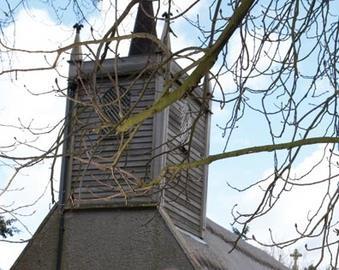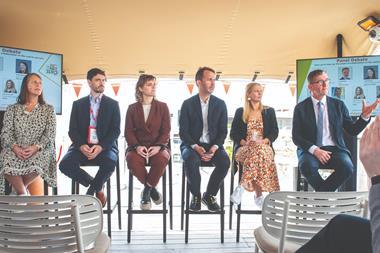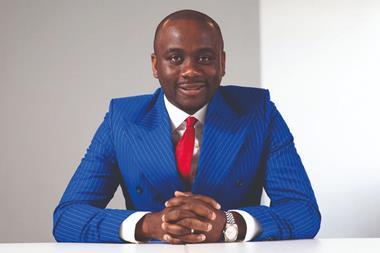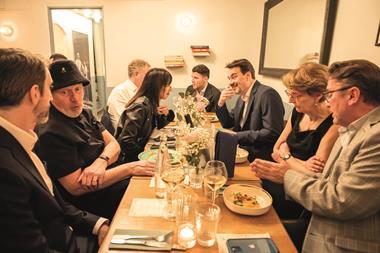With congregations in sharp decline, the Church of England must widen its buildings’ uses if it is to preserve its estate. This week’s Easter celebrations have exposed the plight of the Church of England’s estate. Meanwhile, other religions are thriving. David Hatcher investigates.
‘It’s all very well talking about preservation, but for what? We’ve got to face up to reality these churches can’t go on.’
Sir Roy Strong, historian, high steward of Westminster Abbey and devout Anglican is calling for the closure of half of the Church of England’s rural churches in England. Falling congregations are making many churches too expensive to maintain.
‘There are 10,000 rural churches in this country. There ought to be 5,000. It’s crazy,’ he tells Property Week.
The Church of England closes around 30 churches each year – under 0.2% of its total – and Sunday church attendance fell by 7% between 2000 and 2006. While the Anglican Church is suffering a fall in congregations, many other religions are experiencing a rise in worshippers (see boxes).
There are 16,200 functioning Anglican churches in England, which play host to 983,000 practising Anglicans each week. Many churches are ancient, listed buildings that are costly to sustain. Typically, they are underused on weekdays and the Church is encouraging vicars to offer their buildings for broader community uses, such as creches and post offices, to increase revenue.
But, if churches do close, there will be development opportunities for the private sector.
‘I have to deal with churches where the roof is falling down. It’s not what I went into the job for, that’s for sure,’ says Reverend Nigel Evans of the Chet Valley benefice in Norfolk. ‘We very much struggle to get enough [worshippers] in to pay the bills. We have to rely on grants from English Heritage to try and get by.’
Of the five churches that Evans preaches to in his benefice, the size of the congregations can be ‘sometimes around a dozen and sometimes nearly no one at all’.
This can, however, reflect up to 25% of the surrounding population because the churches are in small villages that have experienced urban migration to centres like Norwich, Great Yarmouth and King’s Lynn.
So, surely closure and consolidation would be the obvious answer, as Sir Roy Strong suggests?
There are 10,000 rural churches in this country. There ought to be 5,000
Sir Roy Strong
‘No, we have to be everywhere, however large or small the community is. It’s the Church’s duty,’ says Paul Lewis, pastoral and redundant churches secretary for the Church Commissioners, the managing body for the Church of England’s property assets.
‘Distribution has to reflect rural to urban migration by opening more churches in cities but there is still a remaining population that needs to have a place to worship,’ he says.
Evans is in agreement with Lewis rather than Strong and is against the closure of churches experiencing chronically low attendance.
‘I don’t think amalgamation of congregations works really,’ he says. ‘Each congregation is so unique they are unlikely to identify with other villages. If you close churches down, you shut down access and ultimately fewer people attend overall.’
The rise in prices of construction materials has led to many instances of churches being pillaged – there were around 2,500 lead thefts from Church of England churches last year and the Church has had to sell off sites because of high renovation costs. St Margaret’s Church in Hopton, Great Yarmouth, for example, has been put up for sale for £1 because of the Norman building’s renovation costs of £300,000.
‘Historically, the local village used to ensure the upkeep of the building. People used to be pragmatic and replace whatever was damaged with the most appropriate and cost-efficient materials,’ says Stephen Bowler, who is on the Church of England advisory committee.
‘The modern view is to learn to respect the past and emphasise preservation. This can be expensive and frustrating.’
An estimated £925m will be needed over the next five years to maintain and restore the Church’s buildings to a good level. The Church estimates that it will be able to raise around £625m of this figure through donations and fundraising, of which English Heritage will contribute 6%.
However, after other deductions it will still be left with a £270m shortfall. It is in discussions with the government to contribute half of the total but no timeframe has yet been set to come to an agreement.
Flock exchange
It is a waste of a perfectly good building to just use it on a Sunday. The church is there to serve God and the community. We should look for wider uses
Reverend Nigel Evans, norfolk
To make up some of this shortfall churches will have to make the most of their D1 class usage and increase revenues. Most would be able to double up as medical clinics, creches, education centres, libraries and art galleries.
Strong accepts such alternative uses as ‘a reason to go on’. In the past he recommended taking ‘an axe and hatchet to the utterly awful kipper-coloured choir stalls and pews, drag them out of the church and burn them in order to let in the local community’.
And on this subject the Church Commissioners and Evans who is attempting to set up a farmers market in one of his churches – concur.
‘It is a waste of a perfectly good building to just use it on a Sunday,’ says Lewis. ‘The church itself is supposed to be there to serve God and also to serve the community. We should look for wider uses.’
But where this is not successful churches must come to their ultimate end. This leaves potential for development and the involvement of the private sector. When selling a redundant church the Church Commissioners seeks a seller who proposes to use it for ‘appropriate’ purposes, which generally means that it will not sell to a brewery. This is not the case for all churches outside the Anglican Church, however (see box).
The Church Commissioners is more in favour of residential redevelopments, such as those carried out by Gloucestershire-based developer Stephen Levens. He has converted seven rural parish churches into homes.
‘There are two main types of problem that come with conversion,’ he acknowledges.
‘First there is potential resistance from the local community, and secondly there can be planning and heritage issues. There are instances in which the conservation costs of a church can be higher than the potential end value, which obviously makes them unfeasible.’
Redundancy is considered as an absolute final option, however, and, so long as the Church refuses to cut its numbers, its costs will not fall. The scope for such development and the number of redundant churches are thus likely to hinge only upon the government’s decision on whether it will grant the Church the extra funds it requires to sustain its buildings.
As ever, property and the economy mirrors society. With the religious landscape changing, the implications for hundreds of buildings and places across Britain are profound.
Original print headline - Lord preserve us
Catholicism: strength in numbers
The Catholic church has been boosted by the migration of worshippers from new European Union member states and from South America. For example, 95% of Poles are Catholic and at least 68,000 Poles migrated to the UK in 2006, staying for at least one year.
But it is also enduring rural migration and decaying buildings. There was a 6.7% decrease in weekly attendance rates in England and Wales between 2001 and 2006 but, since then, it is estimated that this has been counteracted by migrant worshippers. In the same period the number of churches fell from 2,813 to 2,627 – a 6.6% drop.
‘Some churches have taken on a new lease of life with large influxes from abroad,’ says Sophie Andreae, vice-chairman of the Patrimony Committee in England and Wales.
‘But in northern cities with large, dense populations, such as Bradford, where the predominate inward population shift had at one time been Catholic, it is now predominantly Asian.’
English Heritage has carried out research for six of the Catholic Church’s dioceses, and ‘Taking Stock’ in some areas, as the investigation has been entitled, is a necessary exercise.
‘All of the [six] dioceses are experiencing declining populations and in the number of young men joining the clergy’, says Sarah Brown, head of research policy for places of worship at English Heritage. ‘Dioceses are having to make difficult decisions about how many buildings they can sustain.’
When Catholic churches do come to be redeveloped the Church does not insist that they are not turned into drinking holes. Urban Splash endured the removal of dead bodies and dry rot to restore St Peter’s Church in Liverpool, which is now Alma de Cuba, a restaurant and cocktail bar.
Islam: sharia funding for expansion
In contrast to the Anglican congregation, the Muslim community in the UK has grown rapidly in recent years to around 1.6 million and this has caused the number of mosques to increase from 584 in 1999 to 1,445, a 147% rise. This has been helped by the introduction of sharia finance.
Tariq Hameed, business and economics committee secretary
at the Muslim Council of Britain, explains the previous predicament.
‘Under sharia law it is not possible to take a normal mortgage or take on debt for an acquisition or development as it forbids interest payments,’ he says.
‘As a result, if a mosque was at full capacity and wanted to acquire an adjoining site or a person or group of people wanted to acquire a site for a new mosque, it would have to raise all of the equity in one go.’
But, as Shaheer Abbas, chief compliance officer and product manager at the Islamic Bank of Britain explains, this is no longer the case and new financial products are available to
assist such transactions.
‘As a bank we go into partnership in order to provide property finance,’ Abbas explains. ‘We legally keep the property and have a lease agreement with the party to whom we are going into partnership with.’
The bank’s partner then buys out the bank over time in a series of instalments, in addition to paying a rent on the lease.
Universal Church of the Kingdom of God: multichannel approach
Founded in the UK in 1995, the UCKG is a pentecostal evangelical church that originated in Brazil in 1977 and then spread to the US and Africa.
Since 1995 it has set up 35 branches across the country – 16 ‘special works’ that are hired and 19 full-time centres on which it holds a variety of lease and freeholds. It has an active membership of around 4,500. It attracts worshippers through its two Sky TV channels, Passion TV and MyChannel, and its radio station, Liberty Radio.
When looking for new venues it looks for a minimum of 3,500
sq ft single-floor buildings to accommodate at least 200 people. Five of its venues are converted churches, although none are former Catholic or Anglican, and one is part of a converted synagogue in Willesden Green. Its headquarters in Finsbury Park is the converted Rainbow Theatre, which holds 1,800 seats.
Paul Hill, property manager at UCKG explains: ‘We set up “special works” in areas where we detect we have interest coming into more major centres from, and then, if there is enough interest in UCKG, we look for a permanent venue.’































1 Readers' comment